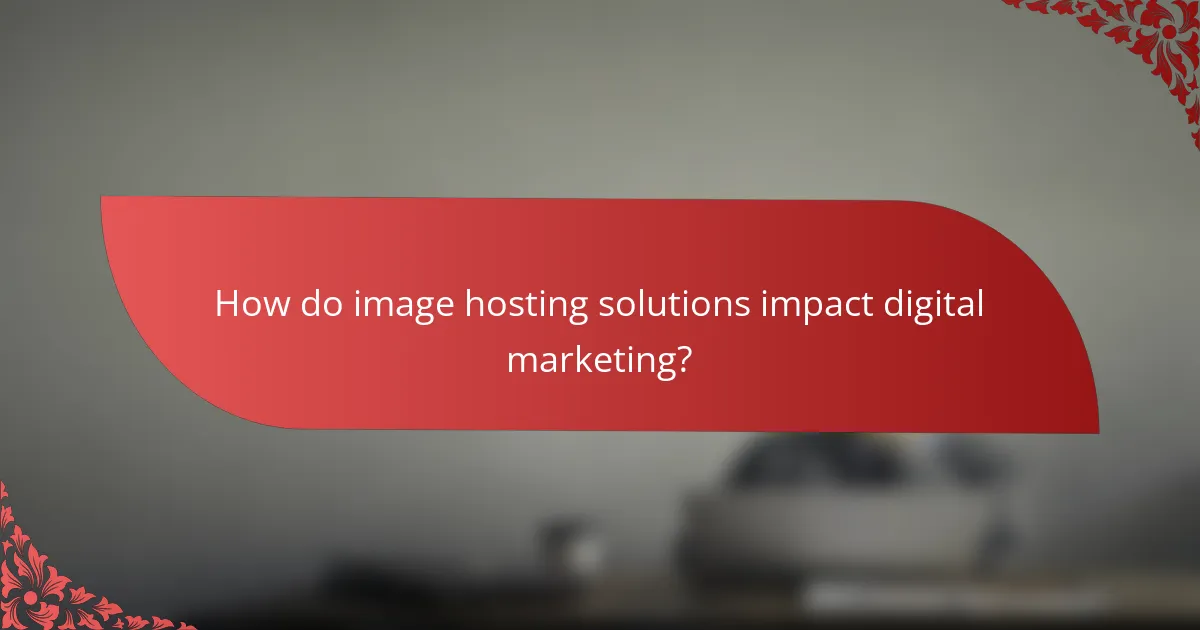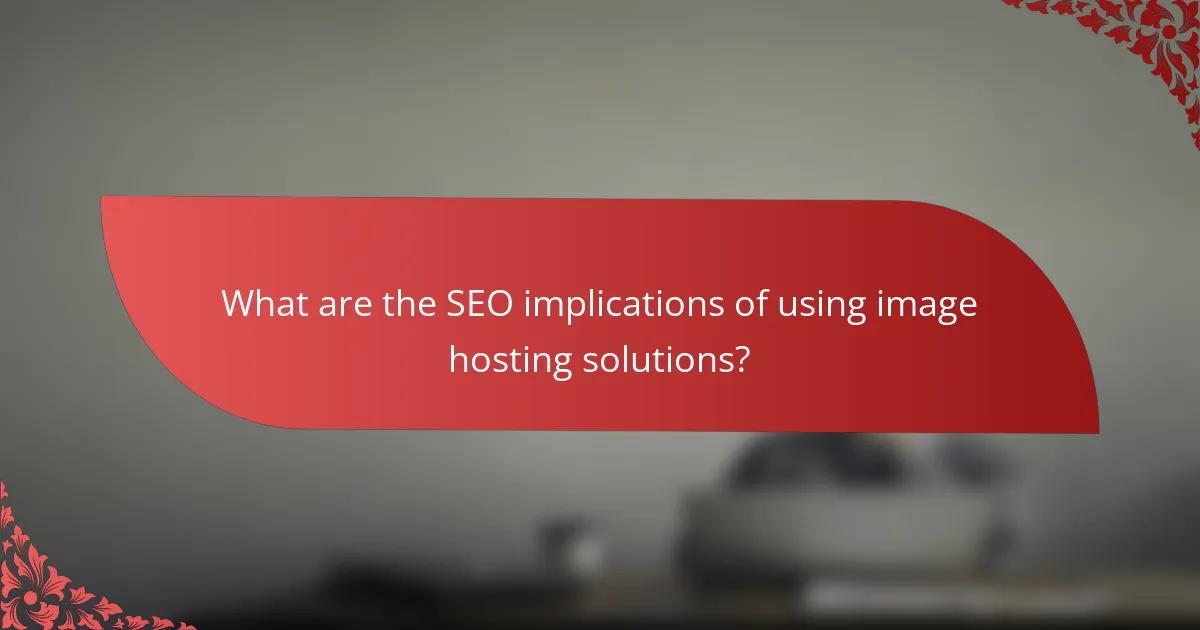In today’s digital landscape, choosing the right image hosting solution is vital for achieving fast loading times, which directly impacts user experience and SEO. Options like Cloudinary, Imgur, and Amazon S3 not only enhance website performance but also play a crucial role in digital marketing by boosting user engagement and search engine visibility.

Which image hosting solutions offer fast loading times in Canada?
In Canada, several image hosting solutions are recognized for their fast loading times, which are crucial for enhancing user experience and improving SEO. Key options include Cloudinary, Imgur, Amazon S3, Google Cloud Storage, and Flickr, each offering unique features and performance benefits.
Cloudinary
Cloudinary is a powerful image hosting solution that optimizes images for fast loading by automatically adjusting file formats and sizes based on user devices. It provides a content delivery network (CDN) that ensures quick access to images from various geographical locations, including Canada.
Consider using Cloudinary if you need advanced features like image transformations and real-time editing. Its pay-as-you-go pricing model allows flexibility for businesses of all sizes, making it a practical choice for digital marketing efforts.
Imgur
Imgur is a popular image hosting platform known for its speed and simplicity. It offers free hosting with fast loading times, making it ideal for casual users and small businesses looking to share images quickly without complex setups.
While Imgur is user-friendly, it may not provide the same level of customization or analytics as other platforms. If you prioritize ease of use and speed, Imgur is a solid option, especially for social media sharing.
Amazon S3
Amazon S3 (Simple Storage Service) is a robust image hosting solution that provides high-speed access and scalability. With its extensive infrastructure, S3 can deliver images quickly to users across Canada, making it suitable for businesses with large volumes of traffic.
When using Amazon S3, consider integrating it with Amazon CloudFront, a CDN that enhances loading times further. This combination is particularly effective for e-commerce sites that require reliable and fast image delivery.
Google Cloud Storage
Google Cloud Storage offers fast image hosting with the advantage of Google’s global infrastructure. Its CDN capabilities ensure that images load quickly for users in Canada, which is essential for maintaining engagement on websites.
Google Cloud Storage is ideal for businesses that already use other Google services, as it integrates seamlessly with tools like Google Analytics. Keep in mind that pricing is based on usage, so monitor your storage and bandwidth to manage costs effectively.
Flickr
Flickr is a well-known platform for hosting and sharing images, particularly for photographers and creatives. It provides fast loading times and a community-oriented approach, making it easy to showcase images while benefiting from social sharing features.
While Flickr offers free accounts, consider the Pro subscription for additional storage and advanced features. This can be beneficial for businesses looking to enhance their digital marketing through high-quality visuals and community engagement.

How do image hosting solutions impact digital marketing?
Image hosting solutions significantly enhance digital marketing by improving website performance, user engagement, and search engine visibility. Fast-loading images can reduce bounce rates and increase conversion rates, making them essential for effective online marketing strategies.
Improved website performance
Using a reliable image hosting solution can drastically improve website performance by reducing load times. Optimized images load faster, which is crucial as users expect pages to load within a few seconds. A well-optimized image can decrease loading time to low tens of milliseconds, enhancing overall site speed.
Consider using formats like WebP or JPEG 2000 for better compression without sacrificing quality. Additionally, leveraging content delivery networks (CDNs) can distribute images globally, further speeding up access for users regardless of their location.
Enhanced user experience
A seamless user experience is vital for retaining visitors and encouraging interactions. Fast-loading images contribute to a smoother browsing experience, which can lead to longer session durations and lower bounce rates. Users are more likely to engage with content that loads quickly and displays well on various devices.
Ensure that images are responsive and adapt to different screen sizes. Implementing lazy loading can also enhance user experience by loading images only when they enter the viewport, thus conserving bandwidth and improving initial load times.
SEO benefits from optimized images
Optimized images play a crucial role in search engine optimization (SEO) by improving page load speed and providing relevant content for search engines to index. Search engines favor fast-loading sites, which can lead to higher rankings in search results. Additionally, properly tagged images with descriptive alt text can enhance visibility in image search results.
To maximize SEO benefits, use descriptive file names and include relevant keywords in your image alt attributes. Regularly audit your images for size and format to ensure they remain optimized as your site evolves.

What features should you look for in an image hosting solution?
When selecting an image hosting solution, prioritize features that enhance performance, reliability, and integration with your marketing efforts. Key aspects include storage capacity, bandwidth limits, and compatibility with various marketing tools.
Storage capacity
Storage capacity is crucial as it determines how many images you can upload and store without incurring additional costs. Look for solutions that offer scalable storage options, allowing you to upgrade as your needs grow. Many providers offer plans ranging from a few gigabytes to several terabytes.
Consider your current and future needs. If you plan to host high-resolution images or a large volume of files, opt for a plan that provides ample storage space. Some services offer unlimited storage, but check for any hidden restrictions.
Bandwidth limits
Bandwidth limits dictate how much data can be transferred from your hosting service to users. High bandwidth is essential for websites with heavy traffic or multiple images, as it ensures fast loading times. Look for plans that offer generous bandwidth allowances or unlimited options to prevent slowdowns.
Evaluate your expected traffic and image usage. If you anticipate spikes in visitors, choose a solution that can handle increased bandwidth demands without additional fees. Be cautious of providers that impose strict limits, as exceeding them can lead to extra charges or throttled speeds.
Integration with marketing tools
Integration with marketing tools enhances your ability to leverage images for SEO and digital marketing. Look for hosting solutions that seamlessly connect with popular platforms like Google Analytics, social media, and email marketing services. This integration can streamline your workflow and improve your marketing efforts.
Consider tools that offer features like image optimization, analytics tracking, and social sharing capabilities. These features can help you analyze performance and make data-driven decisions to enhance your marketing strategies. Ensure the hosting solution you choose supports the tools you currently use or plan to adopt.

How do you choose the right image hosting solution for your needs?
Choosing the right image hosting solution involves evaluating factors like pricing, user feedback, and scalability. A suitable provider should meet your specific requirements for speed, storage, and accessibility while aligning with your budget and growth plans.
Evaluate pricing plans
When assessing pricing plans, consider both the upfront costs and any recurring fees. Many providers offer tiered pricing based on storage capacity, bandwidth, and additional features like analytics or CDN integration.
Look for plans that fit your expected usage. For instance, if you anticipate hosting thousands of images, a plan that offers unlimited storage may be more economical in the long run, even if the initial cost seems higher.
Assess user reviews
User reviews provide valuable insights into the reliability and performance of an image hosting service. Check platforms like Trustpilot or G2 for feedback on speed, customer support, and ease of use.
Pay attention to recurring themes in reviews, such as frequent downtime or slow loading times. A service with consistently high ratings in these areas is likely to meet your needs effectively.
Consider scalability options
Scalability is crucial for businesses expecting growth. Ensure the hosting solution can accommodate increased traffic and storage without significant disruptions or additional costs.
Look for providers that offer flexible plans or easy upgrades as your needs change. A good hosting service should allow you to scale up seamlessly, whether you need more storage space or enhanced performance features.

What are the SEO implications of using image hosting solutions?
Using image hosting solutions can significantly impact your SEO by improving site speed and enhancing user experience. Fast-loading images contribute to lower bounce rates and higher engagement, which search engines favor in their ranking algorithms.
Image optimization techniques
Image optimization involves compressing images, choosing the right file formats, and using descriptive file names. Techniques such as reducing file sizes to a few hundred kilobytes or less can help maintain quality while improving loading times.
Consider using formats like WebP for better compression without sacrificing quality. Additionally, always include alt text to describe images, which aids in accessibility and helps search engines understand the content of your images.
Regularly audit your images to ensure they are optimized. Tools like Google PageSpeed Insights can provide insights on image performance and suggest improvements, helping you stay competitive in search rankings.
